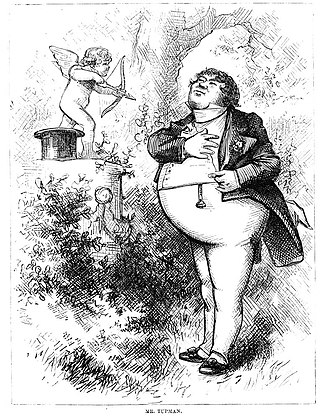
The Pitt Islands are a group of small islands lying immediately off the north extremity of Renaud Island, at the north end of the Biscoe Islands. The name "Pitt's Island," after William Pitt the Younger, the British prime minister, was applied by John Biscoe in 1832 to an island which he erroneously charted as lying about 25 miles West North West of these islands. The present application of Pitt Islands is based on the interpretation of the British Graham Land expedition led by the Australian explorer John Rymill, who charted the island group in 1935–36.
The Mackay Mountains are a prominent group of peaks 10 nautical miles south of the Allegheny Mountains in the Ford Ranges of Marie Byrd Land, Antarctica.

The Guest Peninsula is a snow-covered peninsula about 45 nautical miles long between the Sulzberger Ice Shelf and Block Bay, in the northwest part of Marie Byrd Land, Antarctica.

Nathaniel Winkle is a fictional character in Charles Dickens's first novel, The Pickwick Papers (1836).
The Ickes Mountains are a series of coastal mountains that extend west from Strauss Glacier for 15 nautical miles in Marie Byrd Land, Antarctica.
The Porthos Range is the second range south in the Prince Charles Mountains of Antarctica, extending for about 30 miles in an east-to-west direction between Scylla Glacier and Charybdis Glacier. First visited in December 1956 by the Australian National Antarctic Research Expeditions (ANARE) southern party under W.G. Bewsher (1956-57) and named after Porthos, a character in Alexandre Dumas, père's novel The Three Musketeers, the most popular book read on the southern journey.

Weller Island is an island lying east of Snodgrass Island, Pitt Islands, in the Biscoe Islands. Shown on an Argentine government chart of 1957. Named by the United Kingdom Antarctic Place-Names Committee (UK-APC) in 1959 after Samuel Weller, Mr. Pickwick's servant in Charles Dickens' Pickwick Papers.
Whirlwind Glaciers is a set of four prominent converging glaciers which flow into the west side of Whirlwind Inlet on the east coast of the Antarctic Peninsula. Discovered by Sir Hubert Wilkins on his flight of December 20, 1928, the glaciers were so named because their relative position was suggestive of the radial cylinders of his Wright Whirlwind engine. The Whirlwind Glaciers, comprising Flint, Demorest, Matthes, and Chamberlin Glaciers, were photographed from the air by the United States Antarctic Service (USAS) in 1940; charted by the Falkland Islands Dependencies Survey (FIDS) in 1948.

Jinks Island is an island lying 5 nautical miles (9 km) north of Pickwick Island, in the Pitt Islands of the Biscoe Islands, Antarctica. Shown on an Argentine government chart of 1957, it was named by the UK Antarctic Place-Names Committee in 1959 after Mr. Jinks, a character in Charles Dickens' The Pickwick Papers.

Pickwick Island is the largest of the Pitt Islands, in the Biscoe Islands, Antarctica. It is 9.45 km long in southwest–northeast direction, separated from Renaud Island on the southwest by Mraka Sound, and has its northeast coast indented by Misionis Bay.

Fizkin Island is an island lying 2.5 nautical miles (5 km) southeast of Pickwick Island and 900 m southeast of Arrowsmith Island, Pitt Islands in the Biscoe Islands, Antarctica. The island was shown on an Argentine government chart of 1957, and named by the UK Antarctic Place-Names Committee in 1959 after Horatio Fizkin, Esquire, a character in Charles Dickens' The Pickwick Papers.

Sawyer Island is an island 2 nautical miles long lying north of Pickwick Island, Pitt Islands, in the Biscoe Islands. Shown on an Argentine government chart of 1957. Named by the United Kingdom Antarctic Place-Names Committee (UK-APC) in 1959 after Robert Sawyer, one of the central characters in Charles Dickens' Pickwick Papers.
Smiggers Island is an island lying 1 nautical mile (1.9 km) southeast of Weller Island, Pitt Islands, in the Biscoe Islands. Photographed by Hunting Aerosurveys Ltd. in 1956, and mapped from these photos by the Falkland Islands Dependencies Survey (FIDS). Named by the United Kingdom Antarctic Place-Names Committee (UK-APC) in 1959 after Joseph Smiggers, Esquire, Perpetual Vice President of the Pickwick Club in Charles Dickens' Pickwick Papers.

Slumkey Island is the largest island of the group lying east of Tupman Island, Pitt Islands, in the Biscoe Islands, Antarctica. It is separated from neighbouring Kereka Island to the east-northeast by an 80 m wide passage.

Snodgrass Island is an island 2.5 nautical miles (4.6 km) long lying northeast of Pickwick Island, Pitt Islands, in the Biscoe Islands. Shown on an Argentine government chart of 1957. It was named by the United Kingdom Antarctic Place-Names Committee (UK-APC) in 1959 after the fictional character Augustus Snodgrass, a member of the Pickwick Club in Charles Dickens' The Pickwick Papers.

Snubbin Island is an island lying 2 nautical miles (3.7 km) west of Pickwick Island at the western end of the Pitt Islands, in the Biscoe Islands. Shown on an Argentine government chart of 1957. Named by the United Kingdom Antarctic Place-Names Committee (UK-APC) in 1959 after Mr. Serjeant Snubbin, a barrister in Charles Dickens' Pickwick Papers.

Arrowsmith Island is a mostly ice-covered island in the Pitt group of Biscoe Islands, Antarctica. It is 2.53 km long in west-southwest to east-northeast direction and 900 m wide.

Winkle Island is the island lying between Tula Point and Pickwick Island, Pitt Islands, in the Biscoe Islands. It is separated from Renaud Island to the southwest by Mraka Sound.

Tracy Tupman is a fictional character in Charles Dickens's first novel, The Pickwick Papers (1836). Although fat and middle-aged he considers himself a young lover and has an unfortunate amorous entanglement with the spinster Rachael Wardle.















